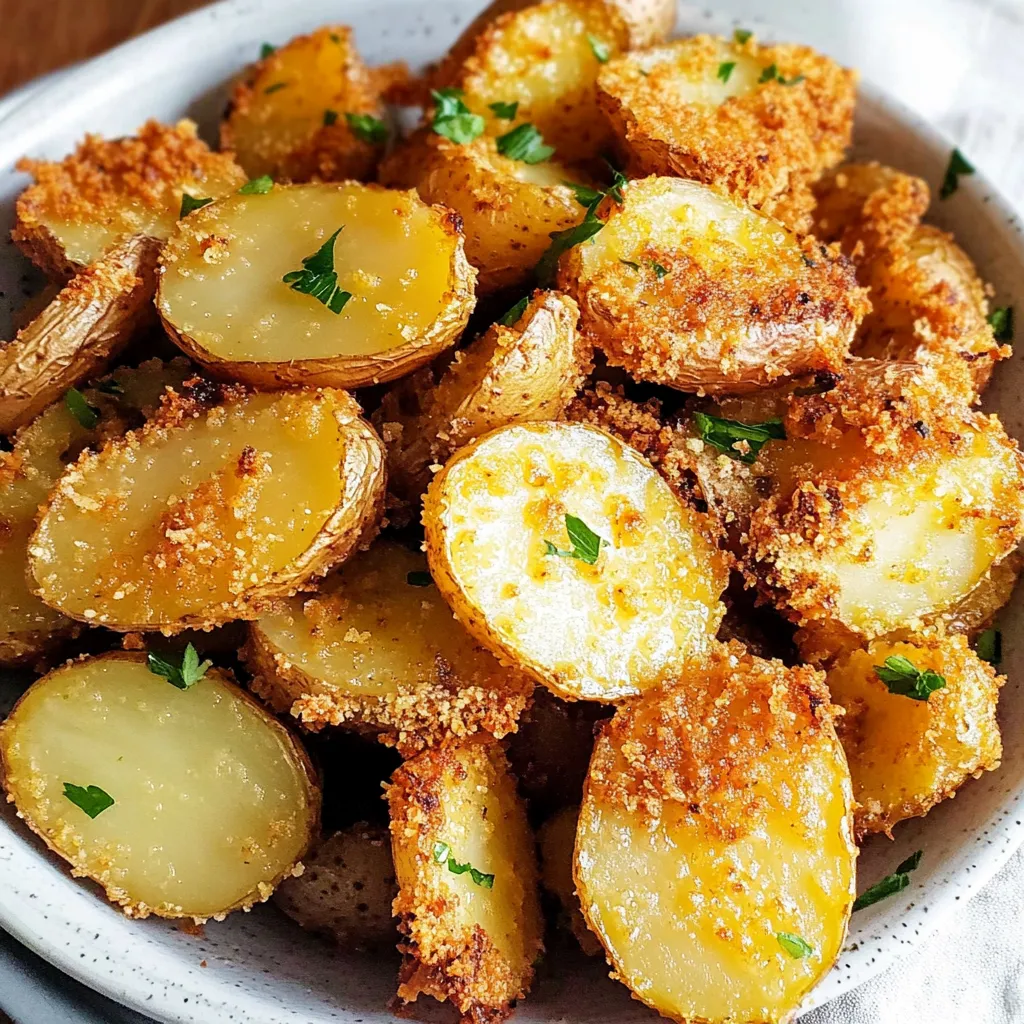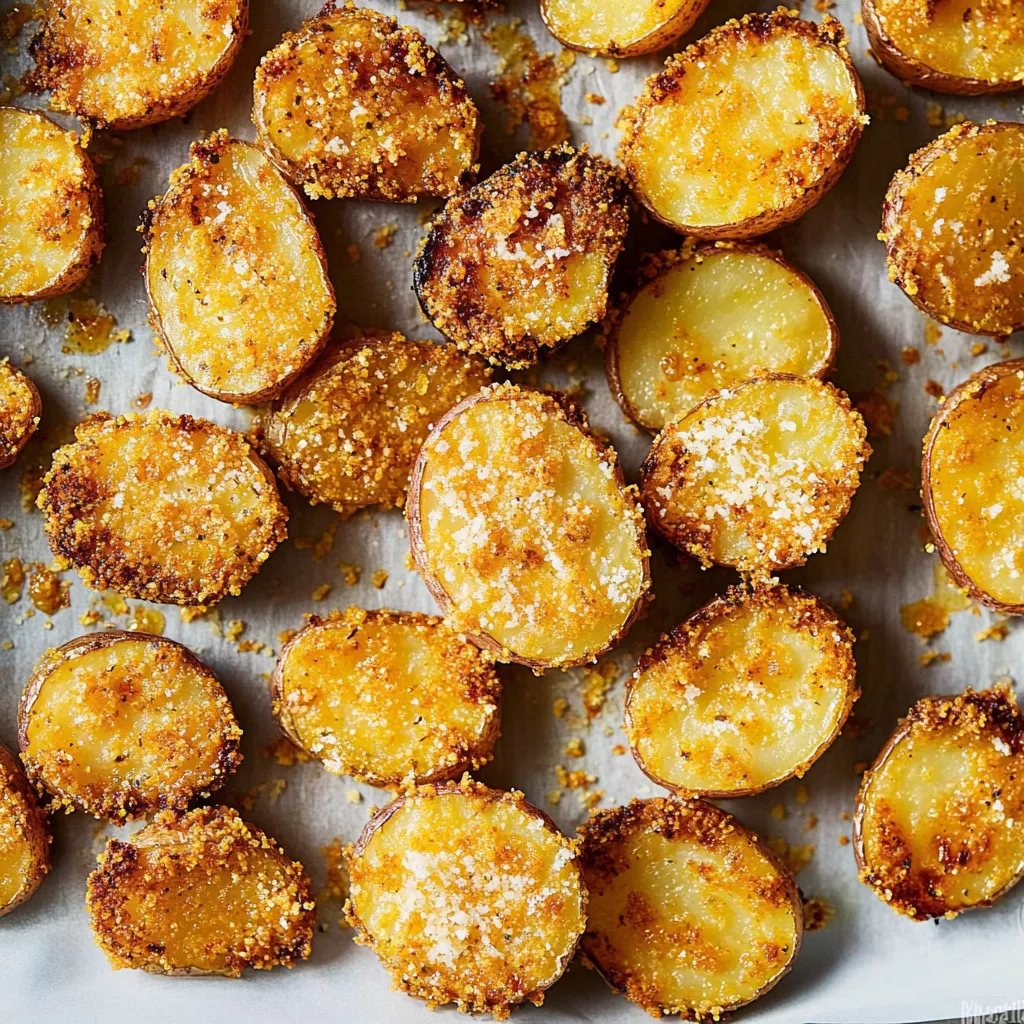 Pin it
Pin it
These golden, crispy parmesan crusted potatoes create the perfect combination of tender, fluffy interiors and incredibly crunchy cheese exteriors that will have everyone reaching for seconds. The simple technique of pressing halved potatoes into a seasoned parmesan and butter paste transforms ordinary baby potatoes into something that looks and tastes like it came from an upscale restaurant. Unlike complicated potato dishes that require multiple steps, this recipe delivers maximum impact with minimal effort, making it perfect for both weeknight dinners and special occasions.
I discovered this recipe during a particularly busy holiday season when I needed something impressive but didn't have time for complicated side dishes. The first time I made them, my guests literally stopped mid-conversation to ask about these potatoes - they couldn't believe something so simple could taste so incredibly good. Now they've become our family's signature potato dish for every gathering.
Essential Ingredients and Selection Tips
- Baby yukon gold potatoes: Choose potatoes that are roughly the same size for even cooking; look for firm specimens without green spots or sprouting eyes
- Fresh parmesan cheese: Grate it yourself from a block for the best melting properties and flavor; pre-grated cheese contains anti-caking agents that don't crisp as nicely
- Real butter: Use unsalted butter so you can control the salt level; the butter helps create the paste consistency and adds richness that complements the cheese
- Garlic powder: Choose granulated rather than salt-based garlic powder for better flavor control and distribution throughout the paste
- Dried oregano: Use oregano that's still fragrant and green; old, gray oregano has lost its flavor potency and won't contribute much to the final dish
- Fresh chives: Select bright green chives without yellowing tips; these add color and fresh onion flavor that cuts through the rich cheese coating
The secret to achieving that perfect crispy crust is creating a thick enough paste that will adhere to the potatoes and brown beautifully in the oven. Too thin and it won't crisp; too thick and it might burn before the potatoes cook through.
Detailed Step-by-Step Instructions
- Step 1: Prepare the oven and potatoes:
- Preheat your oven to 425°F and position the rack in the center for even heat distribution. Wash the baby potatoes thoroughly under cold running water, scrubbing gently to remove any dirt, then pat them completely dry with paper towels. Slice each potato in half lengthwise, creating flat surfaces that will sit nicely in the baking dish.
- Step 2: Score the potato flesh:
- Using a small, sharp paring knife, make shallow cuts in a crosshatch pattern across the cut surface of each potato half - about ¼-inch deep and ½-inch apart. These scores help the potatoes cook more evenly and give the parmesan mixture places to nestle in, creating better adhesion and more flavor penetration.
- Step 3: Create the parmesan paste:
- In your baking dish (a 9x13 inch dish works perfectly), combine the melted butter, freshly grated parmesan cheese, garlic powder, oregano, salt, and black pepper. Use a fork to mix everything together vigorously until it forms a thick, paste-like consistency that holds together when stirred. The mixture should be thick enough to coat the back of a spoon but spreadable.
- Step 4: Adjust paste consistency:
- If your paste seems too thin and runny, add more grated parmesan a tablespoon at a time until it reaches the right thickness. If it's too thick to spread easily, add a tiny bit more melted butter. The ideal consistency should be thick enough to cling to the potatoes but not so thick that it won't spread evenly across the dish.
- Step 5: Arrange the potatoes:
- Place the scored potato halves cut-side down into the parmesan paste, nestling them snugly against each other so the entire bottom of the dish is covered. Gently press each potato down into the paste to ensure good contact and coating on the bottom surfaces.
- Step 6: Add final cheese layer:
- Sprinkle additional grated parmesan generously over the tops of the potatoes - this creates extra crispy bits and ensures even browning. Don't be shy with this final layer, as it's what creates those beautiful golden-brown crispy edges that make this dish so special.
- Step 7: Bake to golden perfection:
- Place the dish in the preheated oven and bake for 20-25 minutes, checking after 18 minutes to ensure the cheese isn't browning too quickly. The potatoes are done when the cheese is golden brown and crispy, and a knife easily pierces through the potato flesh. For extra crispiness, bake an additional 2-3 minutes, watching carefully to prevent burning.
- Step 8: Rest and finish:
- Remove from the oven and let the potatoes rest for 3-5 minutes - this cooling time helps the cheese coating firm up and adhere better to the potatoes. Sprinkle with freshly chopped chives for color and fresh flavor contrast before serving immediately.
 Pin it
Pin it
The most important technique is creating the right paste consistency and not rushing the browning process. The cheese needs time to develop that golden, crispy exterior while the potatoes cook through completely.
This recipe has become such a family favorite that my kids actually request it over french fries when we're having special dinners. There's something so satisfying about that crispy cheese coating giving way to fluffy, perfectly seasoned potato underneath - it hits all the comfort food notes while still feeling sophisticated enough for company.
Understanding Potato Varieties and Cooking Properties
Yukon Gold potatoes are ideal for this recipe because of their naturally creamy texture and thin skin that doesn't need peeling. Their moderate starch content means they hold their shape well during roasting while developing a fluffy interior. Unlike russet potatoes, which can become too dry, or waxy red potatoes, which might not get fluffy enough, Yukon Golds provide the perfect balance. Baby potatoes cook more quickly and evenly than larger ones, and their uniform size ensures consistent results. The natural sugars in these potatoes also caramelize beautifully with the cheese coating, contributing to that gorgeous golden-brown color.
Cheese Selection and Melting Science
The type and preparation of parmesan significantly affects the final texture and flavor of these potatoes. Freshly grated parmesan from a block contains natural moisture and oils that help it melt and crisp properly, while pre-grated cheese often contains cellulose powder that can interfere with browning. Aged parmesan provides more intense flavor and better crisping properties than younger cheeses. The proteins in parmesan behave differently than softer cheeses when heated - they form a crispy crust rather than becoming gooey, which is exactly what creates that coveted golden exterior. Pecorino Romano can be substituted for a sharper, saltier flavor profile.
Heat Distribution and Browning Techniques
Proper oven positioning and temperature control are crucial for achieving evenly browned, crispy potatoes. The center rack provides the most consistent heat circulation, while 425°F is hot enough to crisp the cheese without burning it before the potatoes cook through. The flat cut surface pressed against the hot pan creates direct heat contact that helps develop the crispy bottom crust. If your oven runs hot or you notice the cheese browning too quickly, tent the dish lightly with foil for part of the cooking time, then remove it for the final few minutes to finish browning.
Scoring Techniques and Flavor Penetration
The crosshatch scoring serves multiple important purposes beyond just appearance. The cuts create more surface area for the seasoned butter and cheese mixture to penetrate, ensuring flavor throughout rather than just on the surface. The scoring also helps the potatoes cook more evenly by creating pathways for heat to reach the center more quickly. The depth of the cuts matters - too shallow and they won't make much difference, too deep and the potatoes might fall apart. The ¼-inch depth provides the perfect balance for both cooking efficiency and structural integrity.
Make-Ahead Strategies and Reheating Methods
While these potatoes are undeniably best served fresh from the oven, they can be partially prepared in advance for easier entertaining. You can score the potatoes and prepare the cheese paste up to 4 hours ahead, keeping them covered and refrigerated separately until ready to assemble and bake. For reheating leftovers, use a 375°F oven for 8-10 minutes rather than the microwave, which will make the coating soggy. Adding a sprinkle of fresh parmesan before reheating can help restore some of the crispy texture, though they'll never be quite as perfect as when first made.
These parmesan crusted potatoes have become my proof that the most impressive dishes often come from the simplest techniques executed properly. Every time I make them, I'm amazed at how something so straightforward can consistently deliver such incredible results, reminding me that good cooking isn't about complexity - it's about understanding how flavors and textures work together to create something memorable.
Frequently Asked Questions
- → What type of potatoes work best for this recipe?
- Baby potatoes or small red potatoes work perfectly. They hold their shape well and have the right size for even cooking.
- → Can I use pre-grated parmesan cheese?
- Fresh grated parmesan works best for the crispiest results, but pre-grated will work too. You might need a bit more to get the right paste consistency.
- → How do I know when the potatoes are done?
- Look for golden brown cheese and potatoes that feel tender when pierced with a fork. This usually takes 20-25 minutes at 425°F.
- → Can I make these potatoes ahead of time?
- These are best served fresh from the oven when they're crispiest. You can prep the ingredients earlier but bake right before serving.
- → What can I serve with parmesan crusted potatoes?
- They pair great with grilled chicken, steak, pork chops, or any main dish. They also work well as an appetizer or party side dish.
- → How should I store leftover potatoes?
- Store leftovers in the fridge for up to 4 days in an airtight container. Reheat in the oven to get some crispiness back.
